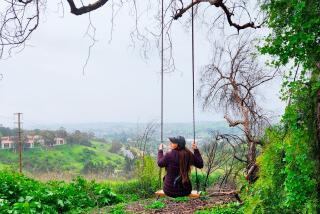The joys of snowshoeing
- Share via
Reporting from Green Valley Lake, Calif. — Winter hopscotched into Southern California early this year, riding an arctic blast of air and snow at local ski resorts. On the mountain, there was elation — plus jammed parking lots, hordes of noisy boarders and skiers, crowded runs and long lift lines.
I don’t want to sound smug, but while all that hoopla was going on, I was reveling in the backcountry stillness of a national forest. Crisp air, bright blue sky, a fresh dusting of snow. Birdsong occasionally accompanied the crunch of my snowshoes.
OK, so maybe I do want to sound a bit smug.
I also want to give my new sport its due: Snowshoes enabled me to avoid the yammering crowds that flock to the mountains in winter and turn pristine drifts of snow into soggy piles of muck. They afforded me an inexpensive way to leave the beaten track and explore the magical winterscape of the forest.
Snowshoes distribute your weight so you walk across the top of deep snow without sinking, so landscapes that are usually impassable in winter suddenly open to exploration.
Some experts think the activity originated about 6,000 years ago in Asia. Although certainly not new to the U.S., it has been gaining ground in the last decade as converts discover its challenges and benefits.
Last year marked the first time sports outfitter REI offered Outdoor School snowshoe courses, said manager Rebecca Bear, and “every class we scheduled was filled.”
There’s more to come. “We’re excited about our classes planned for this year and will add additional courses as they fill,” she said. (Info: https://www.rei.com/outdoorschool/162.)
Equipment improvements — lighter, easier-to-use snowshoes — have fueled an increase in interest. Some of the earliest shoes, made of bent twigs fastened with rawhide, evolved into wooden frames strung with animal gut. Today’s shoes are constructed of lightweight metal frames and synthetic webbing: My gear was so comfortable that I felt as though I were floating atop the snow. And it’s definitely easier than trying to cross a wintery field in boots.
It’s also “a cost-effective sport,” said Ryan Alford, editor of Snowshoe Magazine. “You’re not going to spend an arm and a leg to do it, like you would if you were boarding or skiing.”
Rental equipment costs about $15 to $20 a day, compared with $50 to $60 for other snow sports. If you’re buying, Alford recommends spending about $300. (My snowshoes were an end-of-season special for $160.) Ski or boarding equipment can set you back $1,000 or more.
You also don’t need to spend $100 a day on a lift ticket. “Snowshoeing is so versatile, you can do it almost anywhere there’s snow,” Alford said.
Many of the nation’s prime ski resorts and national parks — particularly those that feature cross-country skiing — also offer snowshoe trails and trips.
I look my novice walk on a snowy meadow at Yellowstone National Park, (www.nps.gov/yell/planyourvisit/skiyell.htm), where I joined a group of more than a dozen people following a guide. I liked the scenery, but the undulating line of snowshoers left me cold. I dropped back to the end of the line and turned back. We hadn’t seen any wildlife in the 90 minutes I’d spent with the group; shortly after abandoning it, I spotted three Rocky Mountain bighorn sheep.
In California, you can snowshoe throughout the Sierra Nevadas and the Cascades, and at Lake Tahoe, Mammoth and Sequoia and Yosemite national parks; all are known for excellent trails.
And, when the weather cooperates, Southern California’s high-altitude national forests and state parks also boast snowshoe country. The Sierra Club schedules regular outings and training sessions (www.angeles.sierraclub.org/index.asp, [213] 387-4287).
One of my favorite places, the Big Bear Discovery Center — a nonprofit forest-adventure outpost — is to open its snowshoe season on Saturday, weather permitting. Three-hour trips are taken mornings and afternoons on Saturdays and Sundays. “We do a little training — the duck walk and how to sidestep on hills — and have a lot of fun,” said Stacy Gorin, program director for the San Bernardino National Forest Assn., which operates the center (www.nationalforestassociation.org/bigbeardiscoverycenter.php, [909] 382-2790).
My recent trek took me into San Bernardino National Forest near Green Valley Lake, a village about 15 miles west of Big Bear. While other people were eating turkey leftovers, hitting the malls and jamming lift lines, I padded along under trees heavy with fresh snow. I had taken off on a back road, my dog, Darby, gleefully racing ahead of me in pursuit of varmints. He never catches any, but he loves the chase almost as much as he loves snow.
While he searches for critters, I watch the ground for tracks in the snow: raccoons, coyotes, abominable snowmen. I haven’t seen any of the latter, but they may be there. And if they are, they’d be smart to wear snowshoes.
More to Read
Sign up for The Wild
We’ll help you find the best places to hike, bike and run, as well as the perfect silent spots for meditation and yoga.
You may occasionally receive promotional content from the Los Angeles Times.






